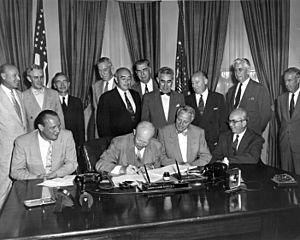Atomic Energy Act of 1954 facts for kids
 |
|
| Long title | An Act to amend the Atomic Energy Act of 1946, as amended, and for other purposes. |
|---|---|
| Enacted by | the 83rd United States Congress |
| Effective | August 30, 1954 |
| Citations | |
| Public law | 83-703 |
| Statutes at Large | 68 Stat. 919 |
| Codification | |
| Acts amended | Atomic Energy Act of 1946 |
| Titles amended | 42 U.S.C.: Public Health and Social Welfare |
| U.S.C. sections amended | 42 U.S.C. ch. 14 |
| Legislative history | |
|
|

The Atomic Energy Act of 1954 is an important U.S. federal law. It helps manage how nuclear materials and facilities are used in the United States. This includes how they are developed, controlled, and even disposed of.
This law updated an earlier one from 1946. It made big changes to how nuclear energy could be used. It especially helped the idea of using nuclear power for peaceful, everyday purposes.
Contents
What the Act Changed
This new law made it possible for private companies to get special information. This information, called "Restricted Data," was about making nuclear energy. It also covered how to produce "fissile materials." Fissile materials are special substances that can be split to release a lot of energy.
Sharing Nuclear Information
The Act also allowed the U.S. government to share more nuclear information with other countries. This was part of President Dwight D. Eisenhower's "Atoms for Peace" program. This program aimed to use nuclear technology for good, like generating electricity.
New Rules for Inventions
Before this Act, it was impossible to get a patent for new ways to create nuclear energy. A patent protects an invention, so others can't copy it. The 1954 Act changed this rule. It allowed people to patent their inventions related to nuclear energy.
How the Law Was Passed
The U.S. Congress passed this important law. It was signed by President Dwight D. Eisenhower on August 30, 1954.
What the Act Means Today
The Nuclear Regulatory Commission is a government agency. They describe the Atomic Energy Act as the main U.S. law. It covers both the peaceful and military uses of nuclear materials.
See also
 In Spanish: Atomic Energy Act de 1954 para niños
In Spanish: Atomic Energy Act de 1954 para niños

